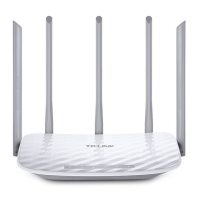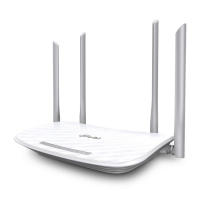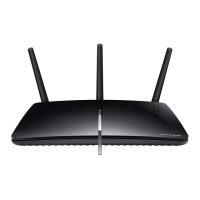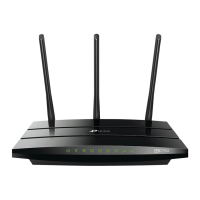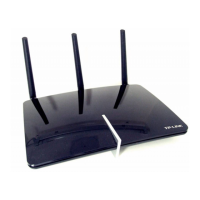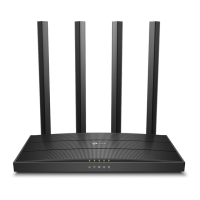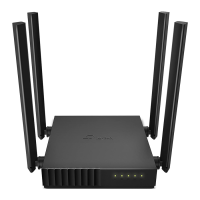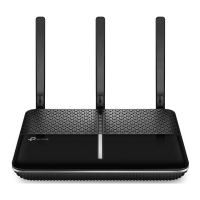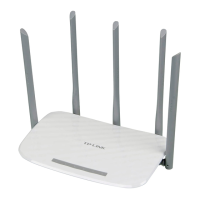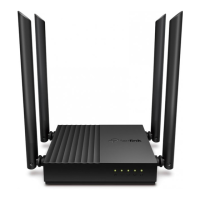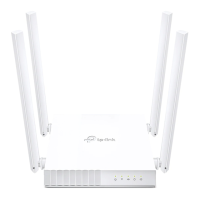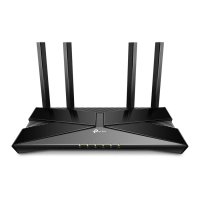Do you have a question about the TP-Link Archer A8 and is the answer not in the manual?
Introduces the router's purpose, features, and benefits for home and small office use.
Details the physical aspects of the router, including its top panel, LEDs, and back panel ports.
Guides on selecting an optimal location for the router, considering environmental factors and connectivity.
Step-by-step instructions for connecting the router to the modem, power, and devices.
Explains how to access the router's web interface for initial setup and management.
Guides users through the automated setup process for internet connection configuration.
Instructions for configuring the router using the TP-Link Tether mobile application.
Details on manually configuring various internet connection types (Dynamic IP, Static IP, PPPoE, etc.).
How to configure the router to extend an existing wired network wirelessly.
Instructions for establishing an internet connection using the IPv6 protocol.
Steps to create a TP-Link ID for cloud management and remote access.
How to update the email address and password associated with a TP-Link ID.
Guides on granting other TP-Link IDs management access to the router.
Procedures to revoke management access for specific TP-Link IDs.
Instructions for using the Tether app for remote router management.
Guides on setting up a separate Wi-Fi network for visitors.
Details on guest permissions, such as client communication and local network access.
How to block websites, limit internet time, and set bedtimes for specific devices.
Explains creating QoS rules to prioritize traffic and manage bandwidth for devices.
How to configure the SPI Firewall to safeguard against online threats.
Guides on blocking or allowing devices using MAC addresses (Blacklist/Whitelist).
How to bind IP to MAC addresses to prevent ARP spoofing and attacks.
Explains ALG settings and recommends default configurations for network protocols.
Instructions for making local services accessible over the internet via port forwarding.
How to dynamically open external ports for applications like games or VoIP.
Explains UPnP for seamless network connections, especially for gaming.
How to expose a device as a DMZ host for unrestricted internet communication.
How to modify the router's local IP address and subnet mask.
Steps to set up the router for IPTV/Phone services, including VLAN configuration.
How to configure DHCP server settings, IP address pool, and reservations.
Guides on setting up DDNS for remote access using a domain name.
How to manually configure routing entries for specific network destinations.
How to change Wi-Fi name (SSID), password, security, and hide SSID.
How to automatically turn the wireless network on/off at specified times.
Instructions for connecting devices using WPS PIN or button.
Configuration of WMM, AP Isolation, Beacon Interval, RTS Threshold, etc.
Guides for updating the router's firmware via online or local methods.
How to save and load router configurations for backup and recovery.
How to change the router's web management login password.
How to control which devices on the LAN can manage the router.
How to enable remote access to manage the router over the internet.
How to save and view system logs for troubleshooting network issues.
Using Ping or Tracert tools to diagnose network connectivity problems.
How to set the router's system time, time zone, and language.
How to schedule automatic reboots to enhance performance.
How to enable Night Mode to turn off router LEDs during specified periods.
| Wi-Fi Standard | 802.11ac |
|---|---|
| Frequency Bands | 2.4 GHz, 5 GHz |
| Maximum Wi-Fi Speed | 1900 Mbps |
| Antenna | 3 external antennas |
| MU-MIMO | Yes |
| Beamforming | Yes |
| LAN Ports | 4 x Gigabit Ethernet |
| WAN Port | 1 x Gigabit Ethernet |
| Wireless Security | WPA, WPA2 |
| Security Features | Guest Network, Parental Controls |
| Dimensions | 9.6 x 6.4 x 1.3 inches (243.8 x 162.6 x 33 mm) |
| Wi-Fi Speeds | 600 Mbps (2.4 GHz), 1300 Mbps (5 GHz) |
